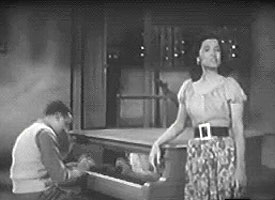 Frankie Carle is at the piano, leaning one arm on the lid, tinkling a pleasant tune with one hand. In walks a young woman, Frankie's daughter Marjorie Hughes. She's acting out the role of a waitress, bringing a meal to a table where a lone fellow is lighting up a cigarette.
Frankie Carle is at the piano, leaning one arm on the lid, tinkling a pleasant tune with one hand. In walks a young woman, Frankie's daughter Marjorie Hughes. She's acting out the role of a waitress, bringing a meal to a table where a lone fellow is lighting up a cigarette.
As she's walking back toward the kitchen, Frankie says, "Oh, Marjorie, how 'bout singing a song for us, huh?"
"Okay," says she, & begins Oh What It Seemed to Be (1950) which had been a hit for Frankie a few years earlier, & was re-recorded by Frank Sinatra.
"It was just a neighborhood dance, that's all that it was/ But oh what it seemed to be/ It was like a masquerade ball, with costumes & all/ Cuz you were at the dance with me/ It was only a ride on a train, that's all it was/ But all what it seemed to be/ It was like a ride to the stars, to venus & Mars/ Cuz you were on the train with me...."
A beautiful ballad composed by Bennie Benjamin, George Weiss, & Frankie Carle, it's sung with charming simplicity with only the piano accompaniment. Frankie's instrumental break has a very classical feel, & Marjorie brings the lyrics home with romantic sweetness.
This is one of the finer Snader telescriptions, nicely staged & marvelously performed with a slimmed down arrangement very unlike the original hit recording. This song had been a big hit for Frankie & his daughter in 1946, when it hit the charts at Number One & stayed there eleven weeks, & elsewhere on the chart for twenty weeks total, & remained the theme song of the Frankie Carle Orchestra, & never mind that Frank Sinatra soon covered it & sold even more copies.
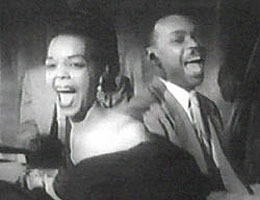 An act billed as "Mr. & Mrs. 88" must've been well known somewhere at sometime, because they're great, but my only exposure to them is the Studio telescription Where There's You There's Me (1952). An act billed as "Mr. & Mrs. 88" must've been well known somewhere at sometime, because they're great, but my only exposure to them is the Studio telescription Where There's You There's Me (1952).
The number 88 refers to the keys of a piano. Not long after these telescriptiosn were filmed, Mr. & Mrs. 88 changed their act's name to the Two Hot Coles, slightly less ridiculous.
They're Eddie & Betty Cole, nee Betty King, older brother & sister-in-law of Nat "King" Cole, in whose shadow Eddie always remained. He'd played with the best, though, beginning with the great Noble Sissle in the 1920s when there was no band anywhere on earth better at ragtime. Anyone w;ho remembers an early television detective series called Bourbon Street Beat (195-) will remember Eddie in a "play it again, Sam" type role, as club pianist "the baron."
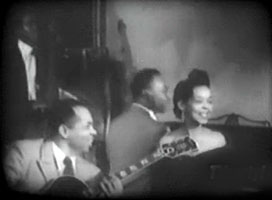 Betty long outlived her husband & played character roles on television & in films throughout her last twenty years. Betty long outlived her husband & played character roles on television & in films throughout her last twenty years.
There's a combo playing, with Mr 88 (i.e., Eddie) at the piano, known both as Eddie Cole & His Gang, & as Eddie Cole's Solid Senders. The first version of the combo backed up Nat King Cole in 1936 with Eddie on bass. Eddie reformed the group after the war, & was the piano man. They were very big in Philadelphia, but national attention was always limited.
Seated nearby is Mrs. 88 (i.e., Betty), who begins singing this first-rate jump-jazz number: "You know wherever there's snow/ There's got to be December/ And where there's June there's a lover's moon/ All the more to remember."
Mr. 88 joins in the vocal but the Mrs. dominates. She's about as good as Etta James; he could just about equals Louis Jordan. That Eddie Cole legitimately sounds a bit like Nat King Cole makes perfect sense, given that he's Nat's older brother.
In all this is damned good stuff. The combo itself seems influenced by the King Cole Trio, which is as fine an influence as could be hoped for. Damn I wish I could go back & time & see this act in a club. I think I'd really rather see Eddie & Betty than Nat!
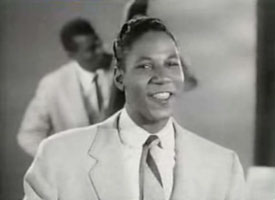 Larry Darnell sing's his 1951 hit Don't Go, Don't Go (1954) as a Studio Films telescription which was sewn into the compilation program for television, Showtime at the Apollo: Blues in Harlem (1955).
Larry Darnell sing's his 1951 hit Don't Go, Don't Go (1954) as a Studio Films telescription which was sewn into the compilation program for television, Showtime at the Apollo: Blues in Harlem (1955).
Filmed live & without an audience on Manhattan's Studio Films soundstage rather than at the Apollo, Larry was backed by the excellent Paul Williams Band, & introduced by the Apollo's emcee Willie Bryant who walk-dances about the stage a bit before leaving Larry to do his song.
Larry was born in 1929 Columbus Ohio as Leo Edward Donald, but cut his teeth as a performer in New Orleans, & is credited along (with a half-dozen others who arrived in New Orleans in the 1940s) with introducing to the long-established Dixieland performers the new Rhythm & Blues sound, which took on its own unique flavor in that great city.
Don't Go is a roots-rock number with bluesy lyrics: "Don't go, don't go, don't say that we are through/ Don't go, don't go, don't say that we are through/ If I lose you baby I don't know what I'll do."
Larry is young & looks great in an icecream suit & striped tie. In fact he's just an extremely good looking guy. So no wonder he got his start in show business touring with Irwin C. Miller's "Brownskin Models" vaudeville review. This was a troupe that required beauty & played mostly burlesque houses, though Larry was only fifteen.
At the instrumental break for Don't Go, we see Paul Williams with his baritone sax stand for a great solo. He rarely arranged to highlight himself in these Studio telescriptions so this is a great moment before returning to Larry's vocal for his big finale.
The same episode of the television variety half-hour included additional Studio telescriptions by the Clovers singing Miss Fanny (1954) Amos Milburn's Down the Road Apiece (1954) & Dinah Washington's Such a Night (1954), plus Snader telescriptions of Duke Ellington (Mood Indigo, 1952; & Sophisticated Lady, 1952) & Herb Jeffries (Baby Won't You Please Come Home, 1950). Emcee Willie Bryant & comic Nipsey Russell help knit it together into the illusion it was a single night's entertainment filmed live at the Apollo.
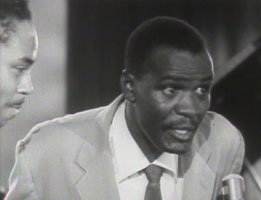 The Clovers sing Hey Miss Fanny or just Miss Fanny (1954), a Studio Films telescription captured live at the Studio soundstage & included in the half-hour compilation Showtime at the Apollo: Blues in Harlem (1955).
The Clovers sing Hey Miss Fanny or just Miss Fanny (1954), a Studio Films telescription captured live at the Studio soundstage & included in the half-hour compilation Showtime at the Apollo: Blues in Harlem (1955).
The telescription version of this number is distinct from the 1952 hit recording. It's a jump-jazz number in a distinctively roots-rock mode, from which can be detected a bit of influence on Little Richard.
Or, it might be suggested on the one hand, it's easy to imagine the Cats & The Fiddle singing this in the '30s, yet it's verging on total rock 'n' roll, with the catchy hook "Hey now, Miss Fanny," echoed in Little Richards' "Good Golly Miss Molly" or "Long Tall Sally."
The Paul Williams band's unnamed alto saxophonist does a rocking solo at the instrumental break while the Covers prance about clapping then return to their microphone positions to continue their great vocal.
Truly one of the great vocal groups of the '50s, with numerous R & B chart hits. The group survived in one form or another for decades, & even tried their hand at disco in the '70s. But it would be their '50s recordings that immortalized The Clovers, who were inducted into the Vocal Group Hall of Fame in 2002.
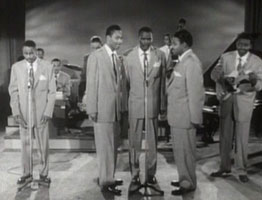 The Clovers perform Da De Day (Fool, Fool, Foll) (1954) for a Studio Films telescription, this one included in the half-hour compilation Showtime at the Apollo: Rhythm in Harlem (1955).
The Clovers perform Da De Day (Fool, Fool, Foll) (1954) for a Studio Films telescription, this one included in the half-hour compilation Showtime at the Apollo: Rhythm in Harlem (1955).
The same episode includes additional Studio telescriptions featuring Larry Darnell (Be Good to Me, 1954), Dinah Washington (I Don't Hurt Anyone, 1954) & Ruth Brown (Oh What a Dream, 1954), with older Snader telescriptions of Herb Jeffries (When I Stop My Song, 1950) & Lionel Hampton (Cobb's Idea, 1951).
As a hit single in 1951, "Fool, Fool, Fool" sold a half-million copies, with slightly different personel than for the Studio telescription
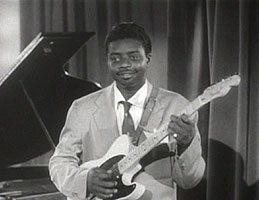 The telescription opens with do-wop "Da de day" harmonizing & no other lyrics. This is most appealing. Then there's a short guitar solo by Bill Harris, the only member of the group who isn't singing. The telescription opens with do-wop "Da de day" harmonizing & no other lyrics. This is most appealing. Then there's a short guitar solo by Bill Harris, the only member of the group who isn't singing.
They're very nearly an a-capela group but for the guitar, akin to the Mills Brothers before them, but with hip update. We do also hear the drummer from the Paul Williams band, & can see the double-bass player is playing but he's not miked.
After the guitar solo, we get lead vocal over the "da de day" harmonizing, with such lyrics as:
"The first time that I met you/ You looked so dog gone sweet/ When you walked down the street/ I said you sure look neat./ Fool, fool, fool, that's how I was to fall for you/ Oh what a fool I was to think you could love me too."
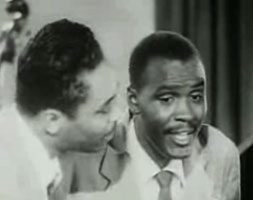 For Lovey Dovey (1954) the Clovers build up a layered doo-wop back-up "doo-doo, ba-baya baya; doo-doo, ba-baya-baya," then begins the lead vocal: For Lovey Dovey (1954) the Clovers build up a layered doo-wop back-up "doo-doo, ba-baya baya; doo-doo, ba-baya-baya," then begins the lead vocal:
"Well you the cutest thing that I did ever see/ I really love your peaches want to shake your tree/ Lovey dovey, lovey dovey all the time/ Lovey dovey, I can't keep you outa my mind..."
A bit of sax can be heard from the otherwise very quiet Paul Williams band behind the four singers & their usual guitar accompanyist.
You can tell the arrangement would be just about as good had it been fully a-capella. This is R & B & simultaneously as much rock 'n' roll as things got in 1954.
Lovey Dovey was included in a string of telescriptions posing as a concert, Showtime at the Apollo: Basin Street Review (1955) together with additional Studio Telescriptions by Faye Adams (Somebody, Somewhere, 1954), Ruth Brown (Hey Momma He Treats Your Daughter Mean, 1954) & Amos Milburn (Bewildered, 1954).
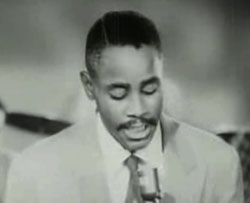 The half-hour trumped up concert also included two older Snader telescriptions, Herb Jeffries' (A Woman is a Worrisome Thing, 1950) & Sarah Vaughan's (These Things I Offer You, 1952). The half-hour trumped up concert also included two older Snader telescriptions, Herb Jeffries' (A Woman is a Worrisome Thing, 1950) & Sarah Vaughan's (These Things I Offer You, 1952).
Tapdancers Coles & Atkins & emcee Willie Bryant are spliced in to enhance the illusion of it having been a night at the Apollo.
The Clovers were one of the most popular vocal group of the 1950s. The group continued in one form or another for a whopping fifty years or longer, with periodic change of personel of course, but these telescriptions capture the original real & true Clovers in their prime period.
Though Studio telescriptions included no bells & whistles, & each of these short films have pretty much an identical look to them, they are true live performances & it's easy to hugely like what one sees & hears.
copyright © by Paghat the Ratgirl
|
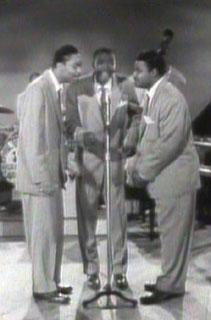


 Betty long outlived her husband & played character roles on television & in films throughout her last twenty years.
Betty long outlived her husband & played character roles on television & in films throughout her last twenty years.


 The telescription opens with do-wop "Da de day" harmonizing & no other lyrics. This is most appealing. Then there's a short guitar solo by Bill Harris, the only member of the group who isn't singing.
The telescription opens with do-wop "Da de day" harmonizing & no other lyrics. This is most appealing. Then there's a short guitar solo by Bill Harris, the only member of the group who isn't singing.
 The half-hour trumped up concert also included two older Snader telescriptions, Herb Jeffries' (A Woman is a Worrisome Thing, 1950) & Sarah Vaughan's (
The half-hour trumped up concert also included two older Snader telescriptions, Herb Jeffries' (A Woman is a Worrisome Thing, 1950) & Sarah Vaughan's (